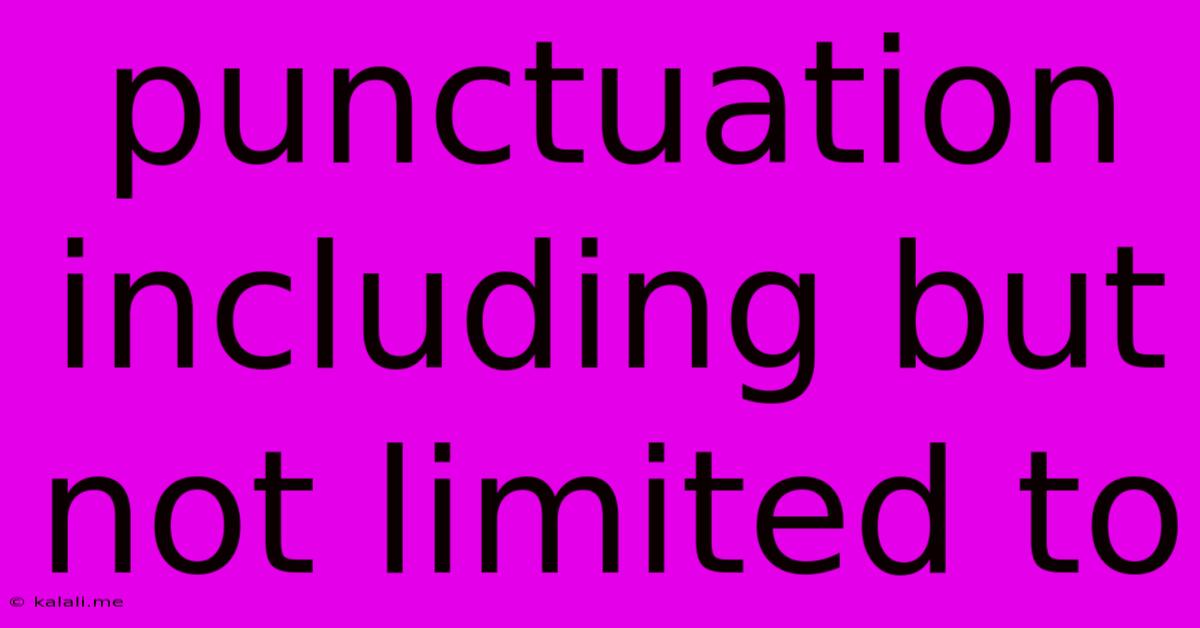Punctuation Including But Not Limited To
Kalali
May 29, 2025 · 3 min read

Table of Contents
Mastering Punctuation: Your Guide to Clear and Effective Writing
Punctuation might seem like a minor detail, but it's the unsung hero of clear and effective writing. Proper punctuation ensures your meaning is conveyed accurately, preventing misunderstandings and enhancing readability. This comprehensive guide covers the essential punctuation marks, their uses, and common mistakes to avoid, transforming your writing from confusing to compelling.
What is Punctuation?
Punctuation refers to the symbols used to organize and clarify written text. These symbols structure sentences, indicating pauses, breaks, and relationships between words and phrases. Mastering punctuation significantly improves the clarity, flow, and overall impact of your writing, making it more engaging for your readers.
The Essential Punctuation Marks:
This section details the most common punctuation marks and their applications.
1. The Period (.): Indicates the end of a declarative sentence (a statement). It also signifies the end of an abbreviation (e.g., Dr., etc.).
2. The Question Mark (?): Used at the end of an interrogative sentence (a question).
3. The Exclamation Mark (!): Expresses strong emotion, emphasis, or surprise. Use sparingly; overuse weakens its impact.
4. The Comma (,): A versatile mark with several uses:
- Separating items in a list: Apples, bananas, and oranges.
- Joining independent clauses with a coordinating conjunction: The sun was shining, and the birds were singing.
- Setting off introductory phrases or clauses: After the rain stopped, we went for a walk.
- Setting off nonrestrictive clauses: My brother, who lives in Paris, is visiting next week. (Note: restrictive clauses, which are essential to the sentence's meaning, do not use commas.)
- Separating coordinate adjectives: The tall, dark stranger. (Note: Do not use a comma between cumulative adjectives—adjectives where one modifies the combination of the others: the bright red dress.)
5. The Semicolon (;): Connects two closely related independent clauses without using a coordinating conjunction. It indicates a stronger pause than a comma but a weaker pause than a period. Example: The storm raged; the trees swayed violently.
6. The Colon (:): Introduces a list, explanation, or quotation. Example: I need three things: milk, eggs, and bread.
7. The Dash (–): Indicates a break or interruption in thought, often more emphatic than a comma or semicolon. Example: I wanted to go—but I was too tired.
8. Parentheses (()): Enclose additional information or asides that are not essential to the main sentence. Example: The capital of France (Paris) is a beautiful city.
9. Brackets [[]]: Used to insert clarifying information within a quotation or to add editorial comments.
10. Quotation Marks (“ ”): Enclose direct quotations and titles of short works (e.g., songs, poems, articles). Note the proper placement of commas and periods relative to the quotation marks.
11. Apostrophes (‘): Show possession (e.g., John's car) and contractions (e.g., can't, won't).
Common Punctuation Mistakes to Avoid:
- Comma splices: Joining two independent clauses with only a comma.
- Misuse of commas with restrictive and nonrestrictive clauses: Incorrect placement can alter the meaning.
- Overuse or underuse of exclamation points: Maintain a balanced tone.
- Incorrect use of apostrophes: This is a common error in possessive forms.
- Inconsistent use of quotation marks: Be consistent in your style.
Improving Your Punctuation Skills:
- Read extensively: Observing punctuation in well-written texts helps internalize correct usage.
- Use a style guide: A consistent style guide (such as the Chicago Manual of Style or AP Stylebook) provides clear rules and examples.
- Practice regularly: The more you write, the better you'll become at using punctuation correctly.
- Use online resources: Many websites and tools offer punctuation guidance and quizzes.
Mastering punctuation is a journey, not a destination. Consistent effort and attention to detail will significantly improve your writing's clarity, impact, and professionalism. By understanding and applying these rules, you'll elevate your written communication to a new level.
Latest Posts
Latest Posts
-
Should Catalog Items Use Digits Or Text For Numerical
May 30, 2025
-
Is The Term Indian Summer Offensive
May 30, 2025
-
How To Take Carpet Glue Off Cement
May 30, 2025
-
They Had Wondered If They Were Doing Well
May 30, 2025
-
Bible Thou Shalt Not Kill Hebrew
May 30, 2025
Related Post
Thank you for visiting our website which covers about Punctuation Including But Not Limited To . We hope the information provided has been useful to you. Feel free to contact us if you have any questions or need further assistance. See you next time and don't miss to bookmark.